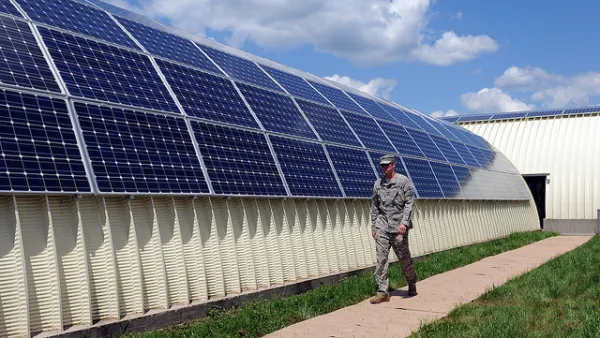Two western states had very similar renewable energy initiatives on the ballot sponsored by NextGen America requiring utilities to get 50 percent of electricity by 2030. It passed in Nevada but was rejected in Arizona.

"Voters overwhelmingly rejected Proposition 127, a ballot measure that would force electric companies to get half of their energy from renewable sources by 2030, the Associated Press projected Tuesday night," report Ryan Randazzo for the Arizona Republic.
California billionaire activist Tom Steyer's political group NextGen America spent heavily to get the measure on the ballot and win over voters, but Steyer was outspent by Arizona Public Service Co. [the largest electric utility in Arizona] and other opponents of the measure.
It easily was the most expensive ballot measure in state history.
It will now be up to the Arizona Corporation Commission, five elected officials who regulate utility rates and policies, to increase the renewable requirement from the current renewable portfolio standard of 15 percent by 2025. Randazzo indicates that the commission is "considering an increase in that standard to get 80 percent of the state's electricity from renewables and nuclear energy by 2050."
Nevada – energy monopoly initiative takes center stage
Clean energy advocates hailed the outcome not only of Question 6, which received nearly 60 percent of vote, and like Arizona Prop. 127, requires utilities to obtain half of their electricity from renewable sources by 2030, but also Question 3, which would challenge the dominance of NV Energy, a Berkshire Hathaway subsidiary providing 90 percent of Nevada's electricity, and allow consumers to pick their own power provider by 2023.
While it's clear why the four clean energy advocacy groups, Southwest Energy Efficiency Project, Western Resource Advocates, Natural Resources Defense Council, and the Sierra Club, would support the renewable energy initiative, additional explanation is needed to explain why they would oppose ending the power monopoly.
The groups argued that the measure, which would "prohibit state-sanctioned electric-generation monopolies" and create a deregulated market, "would interrupt NV Energy’s commitment to double its current level of renewable energy generation by 2023, call into question the future of utility-sponsored energy efficiency programs, and introduce uncertainty into the state’s recovering rooftop solar industry," according to a July 26 press release. The Silver State has a renewable portfolio standard requirement to reach 25 percent by 2025.
Question 3, not the renewable energy mandate, was "one of the most heavily financed political battles in the U.S. election cycle" with almost $100 million spent, according to Bloomberg News.
James DeHaven of the Reno Gazette Journal reports that [a]bout two in three poll-goers rejected the proposed state constitutional amendment, completing almost a 180-degree flip from 2016, when nearly three-quarters of voters approved of the measure." According to Ballotpedia, initiated constitutional amendments in Nevada need to be approved at two successive general elections.
NV Energy, backed by famed billionaire investor Warren Buffett, spent $63 million convincing Nevadans to change their minds.
Measure backers, among them casino mogul Sheldon Adelson, spent $21 million defending the initiative. It wasn’t enough to bounce back from the loss of several high-profile political endorsements, as well as opposition from many of the state’s environmental and organized labor groups.
Additional information on NextGen's political campaign to increase the use of renewable energy, including a success in Michigan, can be found in last month's post, "Arizona and Nevada to Vote on Renewable Energy Initiatives."
FULL STORY: Arizona voters reject clean-energy measure Proposition 127 by large margin

National Parks Layoffs Will Cause Communities to Lose Billions
Thousands of essential park workers were laid off this week, just before the busy spring break season.

Retro-silient?: America’s First “Eco-burb,” The Woodlands Turns 50
A master-planned community north of Houston offers lessons on green infrastructure and resilient design, but falls short of its founder’s lofty affordability and walkability goals.

Delivering for America Plan Will Downgrade Mail Service in at Least 49.5 Percent of Zip Codes
Republican and Democrat lawmakers criticize the plan for its disproportionate negative impact on rural communities.

Test News Post 1
This is a summary

Test News Headline 46
Test for the image on the front page.

Balancing Bombs and Butterflies: How the National Guard Protects a Rare Species
The National Guard at Fort Indiantown Gap uses GIS technology and land management strategies to balance military training with conservation efforts, ensuring the survival of the rare eastern regal fritillary butterfly.
Urban Design for Planners 1: Software Tools
This six-course series explores essential urban design concepts using open source software and equips planners with the tools they need to participate fully in the urban design process.
Planning for Universal Design
Learn the tools for implementing Universal Design in planning regulations.
EMC Planning Group, Inc.
Planetizen
Planetizen
Mpact (formerly Rail~Volution)
Great Falls Development Authority, Inc.
HUDs Office of Policy Development and Research
NYU Wagner Graduate School of Public Service




























